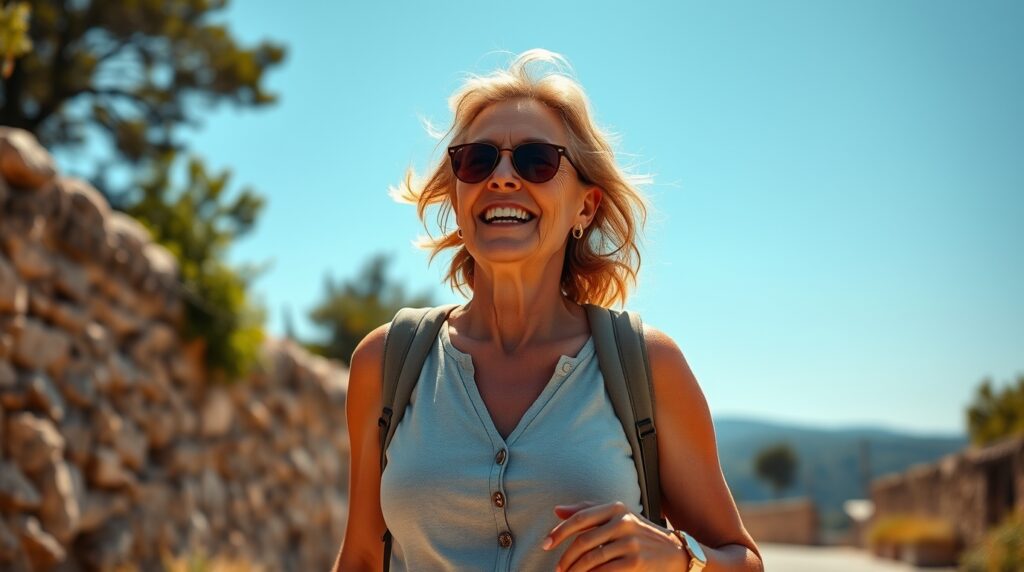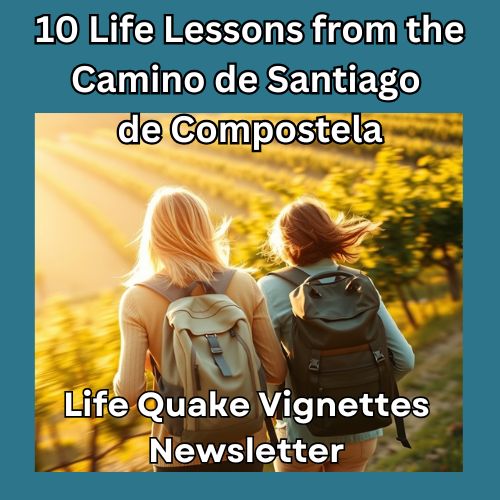Why Your Retreat Participants Need the Opportunity to Tell Their Truth
The Most Powerful Transformative Tool Hiding in Plain Sight
So. You’re leading a wellness retreat in paradise—pristine meditation halls, organic meals, Instagram-worthy sunrises. Your participants dutifully follow the schedule: morning yoga, mindful eating, and silent walks. But despite all the perfect programming, something crucial is missing. Your stressed professionals are going through the motions, but they’re not truly transforming.
Here’s what most retreat leaders miss: beneath every stressed executive, burned-out entrepreneur, and overwhelmed professional lies a story begging to be heard. Not just any story—their story. The messy, imperfect, beautifully human narrative of how they got here, what they’re carrying, and who they’re becoming.
After two decades as a physician witnessing the devastating effects of chronic stress, and ten years guiding professionals through transformational retreats, I’ve discovered the most potent healing tool isn’t found in any wellness manual. It’s not meditation techniques or breathing exercises (though these matter). It’s the revolutionary act of creating sacred space where people can finally tell their truth—and be witnessed in it.
When retreat leaders master this art, something magical happens. Participants don’t just relax; they undergo profound psychological healing that changes them long after they return home. The question isn’t whether you have time for storytelling in your retreat. It’s whether you can afford not to make it central to everything you do.
5 Key Takeaways: The Science Behind Story-Centred Retreat Leadership
1. Authentic Storytelling Accelerates Neuroplasticity When retreat participants share their genuine experiences in a safe environment, they literally rewire their brains. The combination of verbal processing, emotional release, and social witnessing creates optimal conditions for forming new neural pathways that support resilience and stress management.
2. Witnessed Stories Break Isolation Cycles Chronic stress thrives in isolation. When retreat leaders facilitate authentic story-sharing, participants discover they’re not alone in their struggles. This recognition releases shame, reduces cortisol levels, and activates the parasympathetic nervous system—the body’s natural healing state.
3. Narrative Integration Creates Lasting Change. Unlike temporary relaxation techniques, storytelling helps participants integrate their experiences into a coherent life narrative. This integration is what transforms a pleasant retreat weekend into a genuine life transformation that persists months and years later.
4. Story-Centred Retreats Build Deeper Community When retreat leaders prioritise authentic sharing over surface-level activities, participants form profound connections based on shared humanity rather than shared interests. These bonds become ongoing support networks for stress management.
5. Facilitating Stories Develops Leadership Presence Retreat leaders who master the art of holding space for difficult stories develop unshakeable presence and authenticity. This transformation in the facilitator creates ripple effects that enhance every aspect of their retreat leadership.
Tina’s Transformation: When a Retreat Leader Discovered Intentional Listening
The lavender-scented evening air of Provence drifted through the open windows of the converted monastery as Tina Clarkson surveyed her retreat participants. Twenty successful professionals sat in a perfect circle, their faces politely attentive but eyes glazed with the familiar sheen of people going through the motions. The day had unfolded exactly as planned: sunrise meditation, organic breakfast, guided nature walks, mindful lunches. Everything Pinterest-perfect, everything… hollow.
Tina felt the familiar knot of frustration in her stomach, the metallic taste of professional inadequacy rising in her throat. Despite five years of leading wellness retreats, despite the impeccable venue and carefully crafted programs, she watched her participants check their phones during meditation breaks and engage in superficial small talk over gourmet vegetarian meals. The sweet fragrance of jasmine from the garden seemed to mock her efforts—all this beauty, all this intention, yet her participants remained trapped behind invisible walls.
“Before we close with tonight’s gratitude practice,” Tina announced with manufactured enthusiasm, “let’s share something we learned today.” The predictable responses followed: appreciation for nature, the value of slowing down, gratitude for the peaceful setting. Safe. Sanitized. Soulless.
Then Margaret, a corporate lawyer from London, raised her hand slightly. Her voice barely above a whisper, she said, “I learned that I’ve been running from my own story for twenty years.”
The room stilled. Even the cicadas seemed to pause their evening chorus. Margaret’s hands trembled as she continued, “This morning, during the silent walk, I couldn’t stop thinking about my daughter. She died in a car accident three years ago, and I’ve been working eighteen-hour days ever since because… because if I stop moving, I might fall apart completely.”
Tina felt her throat constrict, her rehearsed facilitator responses evaporating. This wasn’t in any manual. Margaret’s words hung in the air like incense—sacred, raw, transformative. The other participants leaned forward, their phones forgotten, their masks of professional competence slipping away.
“I don’t know how to grieve and still be strong enough to lead my team,” Margaret continued, tears reflecting the flickering candlelight. “I came here thinking I needed to learn meditation techniques, but what I really need is to learn how to be human again.”
Tina’s carefully controlled retreat environment shifted in that moment. She could hear her own heartbeat, feel the cool stone beneath her bare feet, smell the lingering aroma of dinner rosemary mingling with Margaret’s quiet courage. Without consulting her schedule or her training manual, Tina made a choice that would transform not only this retreat but her entire approach to healing work.
“Margaret,” she said softly, “would you like to tell us more about your daughter?”
What followed was two hours of the most profound healing Tina had ever witnessed. As Margaret shared stories of her daughter’s laugh, her dreams, her final phone call, other participants began opening their own carefully guarded chambers of pain. David, a tech entrepreneur, spoke about his father’s disapproval that drove him to work-related exhaustion. Sarah, a marketing executive, revealed her struggle with imposter syndrome that made every success feel fraudulent.
Tina realised she wasn’t facilitating a gratitude circle anymore—she was midwifing a miracle. By simply creating space and asking gentle questions, she watched twenty strangers become a community of wounded healers, each story building upon the last like stones in a cathedral of shared humanity.
The sound of authentic crying replaced polite applause. The smell of vulnerability—slightly salty, completely honest—replaced the artificial fragrance of wellness perfection. The taste of truth, both bitter and sweet, filled the room as participants discovered they could be broken and beautiful simultaneously.
By the retreat’s end, Tina had thrown out her structured program entirely. Instead, she’d created what participants later called “the most transformative weekend of my life”—not through perfect planning, but through imperfect, authentic witnessing of their deepest stories.
Margaret returned to London with more than relaxation techniques. She returned with a community of people who knew her whole story and loved her anyway. Six months later, she’d established a grief support group in her company and reduced her working hours without compromising her leadership effectiveness.
For Tina, that night in Provence became the template for all her future retreats. She learned that her job wasn’t to provide answers but to create questions safe enough to explore. Not to offer solutions but to offer sanctuary. Not to heal people but to create conditions where they could heal themselves through the ancient medicine of witnessed storytelling.
The lavender still perfumes her retreat centre, the meals remain lovingly prepared, the setting continues to inspire. But now these elements serve their true purpose—not as the main event, but as the sacred container holding space for the real transformation that happens when people finally feel safe enough to tell their truth.
The Neuroscience of Witnessed Stories: Why This Matters More Than Meditation
As retreat leaders, we often focus on techniques—teaching meditation, facilitating yoga, providing nutritious meals. While these elements support healing, they’re not the primary agents of transformation. The real magic happens when we create what I call “narrative sanctuary”—safe spaces where participants can share their authentic stories and experience being truly witnessed.
The Neurobiological Impact of Story-Sharing
When retreat participants share personal stories in a supportive environment, several powerful neurobiological processes occur simultaneously. The act of verbalising traumatic or stressful experiences activates both the left hemisphere (responsible for language and logic) and the right hemisphere (handling emotions and creativity). This bilateral brain activation is crucial for processing and integrating difficult experiences.
Moreover, when stories are received with empathy rather than judgment, the listener’s mirror neurons fire in synchrony with the storyteller’s emotional state. This neurological mirroring creates genuine connection and reduces the storyteller’s sense of isolation—a primary factor in chronic stress and depression.
The Polyvagal Response to Witnessed Storytelling
Dr. Stephen Porges’ polyvagal theory explains why witnessed storytelling is so powerful for stress relief. When people feel genuinely heard and accepted, their vagus nerve—the longest cranial nerve connecting the brain to major organs—shifts into its “ventral vagal” state. This is the neurobiological state of safety, connection, and healing.
In contrast, when people carry untold stories or feel misunderstood, they often exist in sympathetic arousal (fight-or-flight) or dorsal vagal shutdown (collapse and numbness). No amount of guided meditation can fully shift someone from these stress states if their fundamental story remains unwitnessed.
Integration vs. Suppression
Traditional wellness approaches often inadvertently encourage emotional suppression through emphasis on “letting go” or “staying positive.” While positive reframing has value, it becomes toxic when it prevents authentic processing of difficult experiences. Retreat leaders who create space for storytelling facilitate integration rather than suppression.
Integration occurs when we can acknowledge our full range of experiences—both light and shadow—within a coherent narrative framework. This integration is what creates lasting resilience rather than temporary relief.
The Therapeutic Power of Group Witnessing
Individual therapy offers valuable healing, but group storytelling in retreat settings provides something unique: the experience of being seen and accepted by multiple witnesses simultaneously. This collective witnessing can repair attachment wounds and social trauma in ways that individual work cannot.
When retreat participants witness each other’s stories with compassion, they also practice extending that same compassion to themselves. This reciprocal healing—where helping others heal ourselves—is perhaps the most profound aspect of story-centred retreat work.
Creating Psychological Safety for Vulnerable Sharing
The key to facilitating transformative storytelling lies in creating what psychologist Amy Edmondson calls “psychological safety”—the belief that one can speak up without risk of punishment or humiliation. Retreat leaders must master several skills to create this environment:
- Modelling vulnerability by sharing appropriate personal stories first
- Holding space without fixing by resisting the urge to offer immediate solutions
- Setting clear containers with time boundaries and confidentiality agreements
- Normalising difficult emotions by naming them as natural parts of the human experience
- Facilitating witnessing skills by teaching participants how to listen without judgment
5 Powerful Prompts for Retreat Leaders to Facilitate Story-Sharing
Prompt 1: The Turning Point Story “Think of a moment in your life when everything changed—for better or worse. This might be a decision you made, something that happened to you, or a realisation that shifted your perspective. Share the story of that turning point and how it shaped who you are today.”
Prompt 2: The Burden You’ve Been Carrying “We all carry invisible weights—stories of shame, failure, loss, or fear that we rarely share. In this safe space, what burden have you been carrying alone? What would it feel like to set it down, even temporarily, by sharing it with us?”
Prompt 3: The Wisdom in Your Wounds “Our deepest wounds often become our greatest sources of wisdom and compassion. Share a story about a time you were hurt, disappointed, or challenged, and the unexpected gifts or insights that eventually emerged from that experience.”
Prompt 4: The Person You Were Before “Tell us about who you were before life taught you to be careful, before you learned to protect yourself, before you built the walls you now carry. What did that earlier version of yourself love? What did they believe was possible?”
Prompt 5: The Story You’ve Never Told “What’s a story from your life that you’ve never fully told anyone? Not because it’s too dark or shameful, but because you’ve never found the right space or the right listeners. What would it mean to finally give voice to that untold experience?”
Further Reading: Essential Books for Story-Centred Retreat Leadership
“Kitchen Table Wisdom” by Rachel Naomi Remen Written by a physician who understands both medical and spiritual healing, this collection of stories reveals how sharing our authentic experiences creates profound healing. Remen’s insights into the difference between fixing people and witnessing their wholeness makes this essential for retreat leaders who want to facilitate rather than heal.
“The Storytelling Animal” by Jonathan Gottschall This fascinating exploration of how stories shape human consciousness explains why narrative is fundamental to psychological healing. Gottschall’s research on how storytelling literally changes our brain structure provides retreat leaders with scientific backing for story-centered approaches.
“Sacred Economics” by Charles Eisenstein While primarily about economics, Eisenstein’s exploration of gift culture and authentic community speaks directly to retreat leaders creating spaces for vulnerable sharing. His understanding of how genuine connection transforms both individuals and communities offers profound insights for facilitating group healing.
“The Way of Council” by Jack Zimmerman and Virginia Coyle This practical guide to creating sacred speaking and listening circles provides retreat leaders with concrete tools for facilitating authentic storytelling. The authors’ decades of experience leading council circles in therapeutic and spiritual settings makes this an invaluable resource for any retreat leader.
“Embracing Change in 10 Minutes a Day” by Dr. Margaretha Montagu My own contribution to this field focuses on using narrative techniques and gratitude practices to navigate major life transitions. Drawing from my experience with significant personal challenges and twenty years of helping others through stress and change, it provides practical frameworks for retreat leaders wanting to integrate storytelling into their programs.
From the Guest’s Perspective
“I attended Margaretha’s retreat as a wellness centre owner, thinking I’d learn new meditation techniques to offer my clients. Instead, I discovered I’d been running spiritual bypassing sessions—helping people feel temporarily peaceful while avoiding their real issues. When Margaretha created space for us to share our actual struggles, not just our gratitude lists, everything shifted. I watched a room full of ‘successful’ people finally admit they were drowning, and in that admission, they found each other. I completely restructured my retreat programs after that weekend. Instead of filling every moment with activities, I now create spacious circles where stories can emerge organically. My retreat evaluations have never been higher, and more importantly, I see genuine transformation instead of temporary relaxation. The courage to let participants be real—messy, broken, human—has made me a better facilitator and a more authentic person.”
— Rachel K., Wellness Centre Owner, California
Frequently Asked Questions
Q: What if participants share something too traumatic or triggering for the group? This is why creating clear containers is essential. Begin each sharing session by establishing boundaries: “Share what feels authentic but not necessarily what feels most dramatic.” Remind participants they can share the existence of an experience without sharing graphic details. As facilitators, we hold space for pain without requiring participants to relive trauma. If someone does share beyond what feels safe for the group, acknowledge their courage and gently guide the conversation toward their resilience and healing journey.
Q: How do I handle participants who dominate story-sharing time? Set clear time boundaries from the start: “We have space for everyone to share for about five minutes each.” Use gentle verbal and visual cues to guide transitions: “Thank you for sharing that powerful story. Let’s hold space now for the next person.” Remember that people who over-share are often desperate to be heard—acknowledge their story while maintaining group safety through structure.
Q: What if I get triggered by a participant’s story and can’t maintain my facilitator presence? First, normalise this reality—retreat leaders are human beings with our own stories and wounds. Develop practices for self-regulation: deep breathing, grounding techniques, or even briefly stepping outside if needed. Consider co-facilitating with someone who complements your triggers and strengths. Most importantly, seek your own therapeutic support to process your stories so they don’t unconsciously interfere with your ability to hold space for others.
Q: How do I know if story-sharing is actually helping or just creating emotional overwhelm? Look for integration signs: participants making connections between their story and others’, expressing relief at being witnessed, or finding new perspectives on old experiences. Overwhelm looks like: inability to stop crying, dissociation, or expressing regret about sharing. Always provide grounding techniques and follow vulnerable sharing with activities that help people integrate and stabilise.
Q: Can introverted participants benefit from group storytelling, or does this approach only work for extroverts? Some of the most profound transformations I’ve witnessed have come from quiet participants finally finding their voice. Offer multiple modalities: verbal sharing, written stories read aloud by facilitators, artwork that tells stories, or partner sharing before group sharing. The key is creating enough safety and variety that everyone can participate authentically, not necessarily identically.
Conclusion: The Sacred Art of Witnessing Human Stories
In our rush to provide solutions, techniques, and transformative experiences, we retreat leaders sometimes forget the most fundamental human need: to be seen, heard, and accepted in our full truth. The stressed professionals who come to our retreats aren’t broken machines needing fixing—they’re human beings carrying stories that have never been fully witnessed.
When we create sacred space for authentic storytelling, we offer something revolutionary in our disconnected world: the experience of being fully known and completely accepted. This witnessing doesn’t just reduce stress—it restores faith in human connection and reminds people of their inherent worthiness.
The retreat leaders who master this art don’t just facilitate temporary relaxation; they catalyse lasting transformation. They understand that healing happens not in the doing but in the being—being present, being authentic, being willing to hold space for the full spectrum of human experience.
Your retreat participants don’t just need another meditation technique or breathing exercise—though these have value. They need permission to be human, space to tell their truth, and the profound healing that comes from being witnessed in their wholeness. When you provide this, you’re not just leading retreats—you’re facilitating miracles.
The question isn’t whether you have time for storytelling in your retreats. It’s whether you can afford to lead retreats without it.
Where Stories Come Alive: Join Me in the French Countryside
Imagine walking ancient pilgrimage paths where millions of seekers have shared their stories across centuries, where each footstep becomes a meditation and every conversation a potential breakthrough. Welcome to my transformational retreats in the heart of southwest France, where the art of witnessed storytelling meets the healing power of mindful movement.
Set in the rolling hills of Gascony, these intimate five-day experiences combine gentle hiking with story-sharing circles that honour both your struggles and your strength. Each walk begins with walking meditation as sunrise paints the countryside gold, followed by mindful walks along scenic trails where the rhythm of your steps naturally opens the pathways to your heart.
Here, you’ll discover the transformative power of sharing your authentic story with fellow travellers who truly understand. My Friesian and Falabella horses serve as gentle witnesses to our human journeys, their presence reminding us that healing often happens in silence as much as in words.
These aren’t typical wellness retreats filled with busy schedules and surface-level sharing. Instead, they’re spacious containers for authentic connection—with yourself, with others, and with the ancient wisdom that emerges when we slow down enough to listen. Through carefully facilitated story circles, solo reflection time, and the therapeutic rhythm of walking meditation, you’ll leave not just refreshed but fundamentally shifted in how you relate to your life’s challenges.
Limited to eight participants to ensure intimate, personalised attention, these retreats offer the perfect balance of structure and spaciousness. You’ll return home carrying not just techniques for stress management, but a community of fellow travellers who have witnessed your authentic story and love you anyway.
Click here for more information and upcoming retreat dates










10 Powerful Life Lessons Learned While Walking the Camino de Santiago – a free guide filled with 10 not just “quaint anecdotes” or Instagram-worthy moments (though there are plenty of those) but real transformations from real people who walked the same insight-giving trail you might want to walk one day – Subscribe to my monthly newsletter to Download the Guide

“I am an experienced medical doctor – MBChB, MRCGP, NLP master pract cert, Transformational Life Coach (dip.) Life Story Coach (cert.) Stress Counselling (cert.) Med Hypnotherapy (dip.) and EAGALA (cert.) I may have an impressive number of letters after my name, and more than three decades of professional experience, but what qualifies me to excel at what I do is my intuitive understanding of my clients’ difficulties and my extensive personal experience of managing major life changes using strategies I developed over many years.” Dr M Montagu

